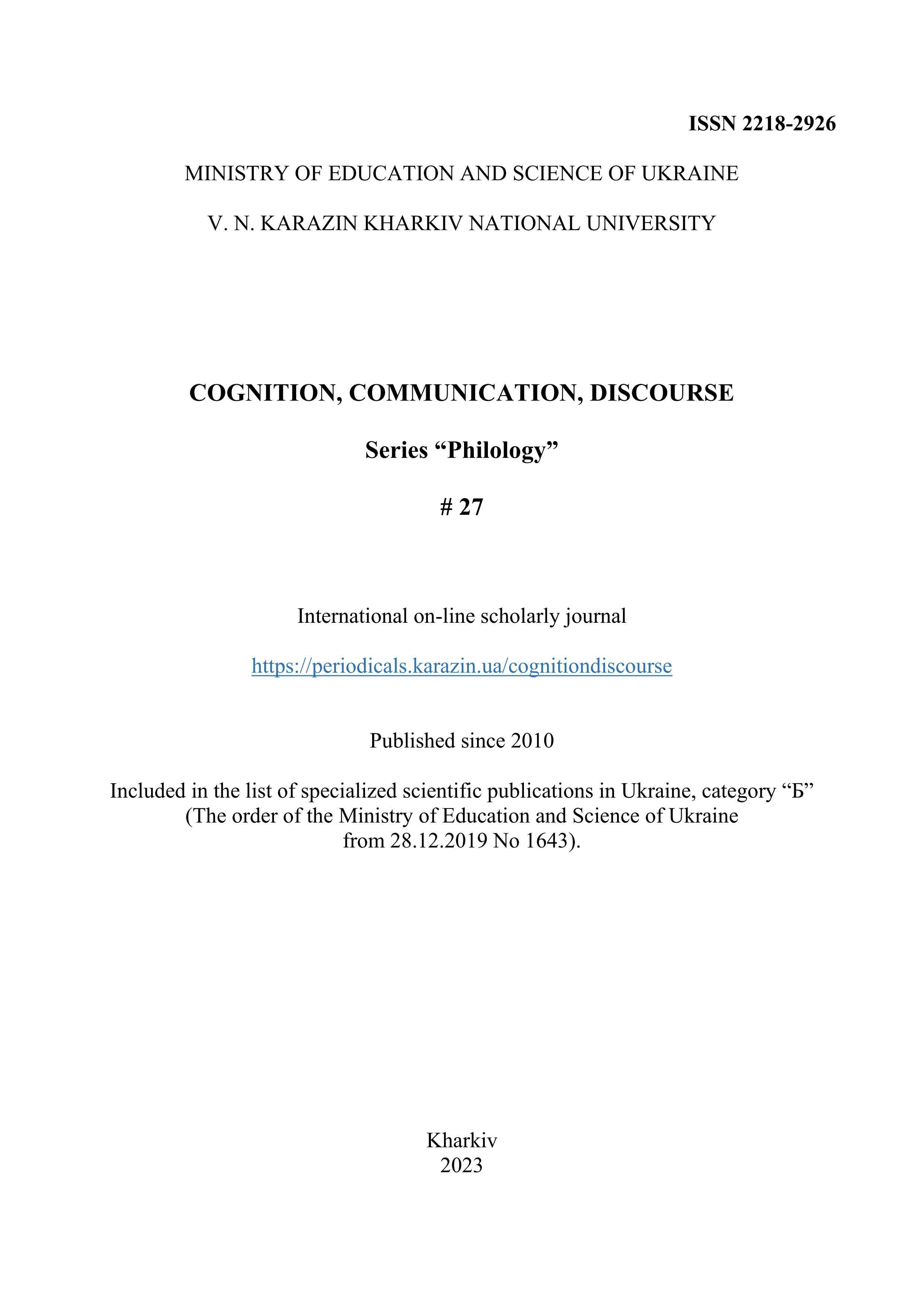Revelative evidential markers in English-language dream reports: A corpus-based study
Abstract
This corpus-based study investigates revelative evidential marking in English dream reports, specifically focusing on the word dream. Analyzing a corpus of 60,155 dream reports, the research identifies the expressions in * dream (in the dream, in my dream etc) and of the dream as most frequent revelative evidentials. The frequency of the central revelative marker in the dream reveals a conventional conceptualization of DREAM IS A CONTAINER, aligning with the broader linguistic metaphor of STATES ARE CONTAINERS. Concordance analysis of the second-frequent phrase of the dream illustrates that narrators tend to use the marker for navigation and coherent narrativization of the dream experiences, conceptualizing the experience as DREAM IS A STORY or DREAM IS A SPACE. Identified with the help of cluster analysis, the trends in dream experience narrativization also emphasize navigation and coherence. The study argues for pragmatic and cognitive implications of evidential marking, which is accounted for by juxtaposing dream content with real-world knowledge via the use of evidential markers in dream reports. It has been found that evidential marking serves to maintain a coherent construal and retain the epistemic control over the conceptualization of the narrated experience. The findings contribute to the expounding revelative evidential labelling, specifically, as well as of the broader semantic evidential system of the English language, advancing the scholarship on linguistic expressions of subjective states and narrativization of subjective experience.
Downloads
References
Aikhenvald, A. Y. (2018). The Oxford handbook of evidentiality. Oxford: Oxford University Press.
Anthony, L. (2023). AntConc [Build 4.2.1.]. Center for English Language Education in Science and Engineering, School of Science and Engineering, Waseda University. Tokyo, Japan.
Bondarenko, I., & Nikolaienko, V. (2022). Like a bad dream: Navigating narrative spaces of pandemic-themed dream reports. Lege artis. Language yesterday, today, tomorrow. The Journal of University of SS Cyril and Methodius in Trnava, 7(1), 2-32. Retrieved from https://lartis.sk/wp-content/uploads/2022/06/bondarenkonikolaienko.pdf
Fludernik, M. (2002). Towards a ‘natural’ narratology. London: Routledge.
Fogli, A., Maria Aiello, L., & Quercia, D. (2020). Our dreams, our selves: Automatic analysis of dream reports. Royal Society Open Science, 7(8), 192080.
Gurajek, B. (2010). Evidentiality in English and Polish. [Master’s thesis, University of Edinburgh, Great Britain]. Retrieved from https://era.ed.ac.uk/bitstream/handle/1842/5313/beata%20gurajek%20thesis_full.pdf;jsessionid=8391cc78808d95fc6333010f7c87a31b?sequence=1
Hendrickx, I., Onrust, L., Kunneman, F., Hürriyetoğlu, A., Bosch, A. V. D., & Stoop, W. (2016). Unraveling reported dreams with text analytics. arXiv preprint. doi:10.48550/ARXIV.1612.03659
Hobson, J. A., Pace-Schott, E. F. & Stickgold, R. (2000). Dreaming and the brain: Toward a cognitive neuroscience of conscious states. Behavioral and Brain Sciences, 23(6), 793-842.
Jakobson, R. (1957). Shifters, verbal categories and the Russian verb. Cambridge: Harvard University Press.
King, R., & Nadasdi, T. (1999). The expression of evidentiality in French-English bilingual discourse. Language in Society, 28(3), 355-365.
Kövecses, Z. (2017). Levels of metaphor. Cognitive Linguistics, 28(2), 321-347.
Kratschmer, A., & Heijnen, A. (2010). Revelative evidentiality in European languages: Linguistic marking and its anthropological background. In G. Diewald & E. Smirnova (Eds.), Linguistic Realization of Evidentiality in European Languages (pp. 331-368). Berlin, New York: De Gruyter Mouton.
Lakoff, G., & Johnson, M. (2008/1980). Metaphors we live by. University of Chicago Press.
Langacker, R. W. (2017). Evidentiality in Cognitive Grammar. In J. I. M. Arrese, G. Haler, & M. Carretero (Eds.), Evidentiality Revisited: Cognitive grammar, functional and discourse-pragmatic perspectives (pp. 13-55). Amsterdam: John Benjamins. doi:10.1075/pbns.271.02lan
Lotman, J. (2009). Culture and explosion. Berlin: Mouton de Gruyter.
Mushin, I. (2001). Evidentiality and epistemological stance: Narrative retelling. Amsterdam: John Benjamins.
Nikolaienko, V. (2023). Patterns of evidentials use in dream narratives. Cognition, communication, Discourse, 26, 83-96. doi:10.26565/2218-2926-2023-26-05
Plungian, V. (2010). Types of verbal evidentiality marking: An overview. In G. Diewald, & E. Smirnova (Eds.), Linguistic Realization of Evidentiality in European Languages (pp. 15-58). Berlin, New York: De Gruyter Mouton.
Squartini, M. (2008). Lexical vs. grammatical evidentiality in French and Italian. Linguistics, 46(5). doi:10.1515/LING.2008.030
Whitt, R. J. (2009). Auditory evidentiality in English and German: The case of perception verbs. Lingua, 119(7), 1083-1095.
Whitt, R. J. (2010). Evidentiality and perception verbs in English and German. Bern: Peter Lang Verlag.
Wiemer, B. (2010). Hearsay in European languages: Toward an integrative account of grammatical and lexical marking. In G. Diewald, & E. Smirnova (Eds.), Linguistic realization of evidentiality in European languages (pp. 59-129). Berlin: Walter de Gruyter.
Copyright (c) 2023 Nikolaienko Valeriia

This work is licensed under a Creative Commons Attribution-NonCommercial-NoDerivatives 4.0 International License.
Authors, who publish with this journal, accept the following conditions:
The authors reserve the copyright of their work and transfer to the journal the right of the first publication of this work under the terms of the Creative Commons Attribution License (CC BY), which allows other persons to freely distribute a published work with mandatory reference to the authors of the original work and the first publication of the work in this journal.
Authors have the right to enter into separate additional agreements for the non-exclusive dissemination of the work in the form in which it was published by this journal (for example, to post the work in the electronic institutions' repository or to publish as part of a monograph), provided that the link to the first publication of the work in this journal is given.
The journal policy allows and encourages the authors to place the manuscripts on the Internet (for example, in the institutions' repositories or on personal websites), both before the presentation of this manuscript to the editorial board and during review procedure, as it contributes to the creation of productive scientific discussion and positively affects the efficiency and dynamics of citing the published work (see The Effect of Open Access).




